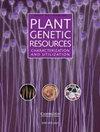camelina sativa (L.)双单倍体品系分子多样性评价作为一种新兴的油料作物
IF 0.7
4区 生物学
Q3 PLANT SCIENCES
Plant Genetic Resources: Characterization and Utilization
Pub Date : 2023-03-08
DOI:10.1017/s1479262123000114
引用次数: 1
摘要
亚麻荠(Camelina sativa, L.)是一种油籽作物,属于十字花科。与主要油料作物相比,亚麻荠有两个独特的特点,一是对不同环境的适应性,二是其独特的油脂成分。培育双单倍体是作物改良的重要手段之一。遗传多样性的研究是规划作物育种方案的一个重要步骤。利用ISSR (inter simple sequence repeat)标记对15个杂交组合获得的81个双单倍体品系的遗传变异进行了分析。扩增条带总数为243条,其中多态性条带239条,占98.3%。多态性频带比例在93.75 ~ 100之间。条带的大小从50到1700个碱基对不等。通过估计标记特征:多态性信息含量、有效多重倍率、标记指数和分辨能力,鉴定出具有信息性的issr。3种标记的分辨能力较高,分别为9.88、8.5和7.46,是鉴定线材信息最多的标记。基于完整算法的聚类分析将双单倍体系划分为5组,从双亲的地理分布格局来看,构型较为明确。主坐标分析将81个亚麻荠双单倍体系划分为6个类群。ISSR标记检测到高多态性,揭示了茶树品系的遗传变异。这项研究的发现,以及对这些品系的生化性状的鉴定,可以改善育种计划,获得更高和更好的含油量的高产亚麻荠品种。本文章由计算机程序翻译,如有差异,请以英文原文为准。
Assessment of molecular diversity in doubled haploid lines of camelina (Camelina sativa (L.) Crantz), as a new emerging oil crop
Camelina (Camelina sativa (L.) Crantz), an oilseed crop, belongs to the Brassicaceae family. Two unique features of camelina in comparison with the main oil crops are an adaptation to different environments and also its unique oil composition. The development of doubled haploid plants is one of the essential methods for crop improvement. The study of genetic diversity is an important step in planning crop breeding programmes. This research was conducted to evaluate the genetic variation of 81 camelina doubled haploid lines obtained from 15 crosses by inter simple sequence repeat (ISSR) markers. The total number of amplified bands was 243, of which 239 bands (98.3%) showed polymorphism. The percentage of polymorphic bands varied between 93.75 and 100. The size of the bands ranged from 50 to 1700 base pairs. The informative ISSRs were identified by estimating marker features: polymorphism information content, effective multiplex ratio, marker index and resolving power. Three markers had higher resolving power values (9.88, 8.5 and 7.46) and were the most informative markers to identify the lines. Cluster analysis based on the complete algorithm divided the lines into five groups, indicating relatively clear configuration from the geographic distribution patterns of the parents of the doubled haploid lines. Principal coordinate analysis classified the 81 camelina doubled haploid lines into six groups. The ISSR markers detected high polymorphism to reveal the genetic variation of camelina lines. The findings of this research, along with the characterization of biochemical traits of the lines, can improve breeding programmes achieve high-yielding camelina varieties with higher and better oil content.
求助全文
通过发布文献求助,成功后即可免费获取论文全文。
去求助
来源期刊

Plant Genetic Resources: Characterization and Utilization
Agricultural and Biological Sciences-Agronomy and Crop Science
CiteScore
2.80
自引率
0.00%
发文量
29
审稿时长
>12 weeks
期刊介绍:
Plant Genetic Resources is an international journal which provides a forum for describing the application of novel genomic technologies, as well as their integration with established techniques, towards the understanding of the genetic variation captured in both in situ and ex situ collections of crop and non-crop plants; and for the airing of wider issues relevant to plant germplasm conservation and utilisation. We particularly welcome multi-disciplinary approaches that incorporate both a technical and a socio-economic focus. Technical aspects can cover developments in technologies of potential or demonstrated relevance to the analysis of variation and diversity at the phenotypic and genotypic levels.
 求助内容:
求助内容: 应助结果提醒方式:
应助结果提醒方式:


